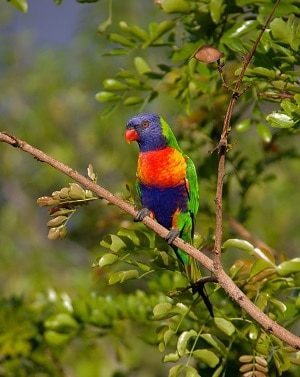How Much Does a Lorikeet Cost?
Last Updated on March 18, 2024
Written by CPA Alec Pow | Content Reviewed by ![]() CFA Alexander Popinker
CFA Alexander Popinker
With their spectacularly colorful plumage and playful, acrobatic nature, lorikeets can make an excellent choice for dedicated exotic bird enthusiasts seeking an interactive pet.
However, properly caring for these uniquely energetic, high-maintenance nectar feeders requires a substantial lifelong financial investment in specialized housing, veterinary care, adequate daily enrichment time, and meeting their complex nutritional requirements.
So, what should prospective pet lorikeet owners realistically budget for in terms of upfront costs and ongoing expenses?
In this guide, we’ll break down the many considerations that factor into lorikeet pricing and ownership responsibilities. From the initial purchase price, vital housing setup, and preventative wellness veterinary visits, to the specialized daily diet, enrichment toys for their active minds and bodies, grooming supplies, lifetime incidental medical expenses, and more.
How Much Does a Lorikeet Cost?
The cost of a Lorikeet can start from as low as $250 and go up to $2,000. Depending on factors like age, rare color mutations, geographic region, and breeder reputation, expect to invest:
- $500-$1,500 purchasing from most respected, responsible avian breeders
- $1,000-$2,000 at specialty bird stores and aviaries
- $250-$500 adopting through lorikeet-specific rescue organizations
Set your maximum budget range for your preferred species and color variation before beginning your search. Understand total ownership costs beyond just the upfront price.
Northern Parrots notes in an article that Lorikeets, particularly Rainbow Lorikeets, are priced around $400 to $700 on average.
HereBird says that Swainson’s Lories, another type of Lorikeet, may cost over $1000 from top-quality breeders.
According to The Spruce Pets, Rainbow Lorikeets can cost from $500 to $1,500, depending on factors like breeders and quality.
A rainbow lory typically costs at least $500–$1000, with prices potentially climbing as high as $2000 depending on the bird and location, as PetMD notes.
Initial Cage and Supply Costs
Be prepared to spend $1,000-$3,000+ on the initial housing setup and accessories a lorikeet needs, including:
- The absolute largest wire cage or walk-in aviary possible to encourage flying and climbing, $500-$2,000+
- Various types of perches, rope toys, puzzle feeders, and enrichment items, $200-$500
- Premium quality food and water bowls, $50-$150
- Basic grooming supplies like nail clippers, $50-$75
Don’t cut corners when it comes to cage size and quality – this will serve as their permanent home. Invest in sufficient space right from the start.
First Vet Visit and Getting a Check-Up
Expect approximately $100-$200 for an initial veterinary wellness exam, covering:
- An overall physical health assessment and condition screening, $75-$100
- Fecal parasites test, $25-$50
- Basic blood panel lab work, $25-$75
- Any recommended vaccinations per state guidelines, $25-$50
It’s vital to establish care with an experienced avian veterinarian right away to ensure your new family member is in optimal health. This creates a health baseline going forward.
Creating a Suitable Habitat and Environment
Allow approximately $1,000-$7,500+ to fully bird-proof their living space and daily surroundings for optimal mental and physical health:
- Purchasing or custom building a roomy wire aviary for plenty of flight, starting around $1,000-$3,000+
- Installing several appropriately sized perches, rope ladders, natural wood branches, platforms, and toys for climbing and exploration, $500-$1,500
- Incorporating organic shredding, bathing, and foraging opportunities to prevent boredom, $200-$500+
- Access to ample UV sunlight via safe outdoor aviaries or indoor full spectrum bulbs, $200-$1,000
- Childproofing any hazards in occupied rooms through thorough bird-proofing modifications, $100-$1,000+
You might also like our articles about the cost of an Eclectus parrot, a Quaker parrot, or an Amazon parrot.
Proper year-round housing promotes healthy, strong feathers, flight muscles, beaks, and bone density long-term.
Typical Ongoing Monthly Lorikeet Expenses
Recurring monthly costs of lorikeet ownership:
- Specialized nectar diet – $30-$100
- Fresh human-grade vegetables, fruits, sprouts – $40-$80
- Premium pellet mix and occasional treats – $20-$60
- Cage accessories and replacement toys – $25-$75
- Grooming supplies and perch replacements – $15-$30
- Routine veterinary exams and lab work – $75-$150
In total, budget $500-$1,000 or more per year for a healthy lorikeet’s regular preventative care, food, and incidentals.
Potential Additional Medical Expenses
 Potential unexpected veterinary costs to keep in mind include:
Potential unexpected veterinary costs to keep in mind include:
- Emergency or after-hours veterinary visits – $150-$750
- Diagnostic lab tests for concerning symptoms- $100-$500
- Short- and long-term prescription medications – $25-$150
- Potential specialty surgeries if major issues arise – $2,000-$10,000+
- Hospitalization and critical care fees – $200-$750+ per day
Pet health insurance policies can help greatly offset surprise vet bills. Unplanned medical costs are where many owners fall short.
Extra Costs for Specialized Lorikeet Care
Added expenditures to consider that further enhance your pet’s quality of life include:
- Constructing a spacious outdoor flight aviary for safe sun and exercise – $2,000-$5,000+
- A sturdy travel cage for veterinary and adventure excursions – $100-$300
- Regular professional grooming and beak trimming services – $50-$150 per session
- Prescription specialty diet if health issues arise – $100-$400+ per month
- Custom cage enrichment installations and backdrop painting – $500-$2,000+
- Boarding and care services when traveling – $15-$50+ per day
Conclusion
In total, estimate investing approximately $2,000-$5,000+ during just the first year of lorikeet ownership, and $1,000-$3,000 annually after that for food, medical care, accessories, and vital enrichment supplies.
While certainly not a cheap pet, devoted bird enthusiasts say the dazzling personality, lifetime companionship, and joy lorikeets bring is profoundly rewarding if given proper love and care. Thoroughly assess the responsibility and be ready to provide excellent lifetime care.
Frequently Asked Questions
How much space do lorikeets need?
Aim to provide the absolutely largest possible housing enclosure that your budget and space allow – minimally 24” x 24” x 36” for one lorikeet, but ideally a roomy walk-in or outdoor flight aviary exceeding 8 feet in height and length.
The more horizontal and vertical flying and climbing room available, the better for supporting their active health and nature long-term.
What is the best lorikeet to have as a pet?
The rainbow lorikeet is often considered the most beginner-friendly lorikeet species to start with thanks to their slightly more laid-back, less noisy personality in captivity.
Particularly high-strung, louder options like the noisy or musk lorikeet are better suited to veteran owners. Always choose friendly hand-fed babies from an ethical, avian-specialized breeder.
How do you toilet train a lorikeet?
Place large flat trays or pans lined with absorbent newspaper, pine pellet litter, or cage liner below their preferred perches to passively catch and collect dropping debris. Be sure to reward them with a small treat immediately when they use the target tray.
Over time, slowly move the catching pan to the desired waste area as they learn. Patience, positive rewards, and environment management are key to successful training.

Leave a Reply
Want to join the discussion?Feel free to contribute!